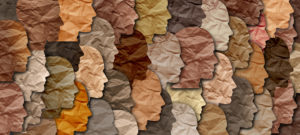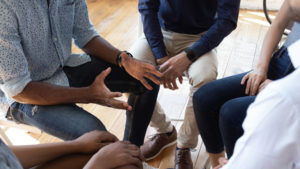
I am taking a break in the series on meeting facilitation to address the current, slow-moving, ongoing crisis we are navigating. I am also sending this eNewsletter to the New Perspectives NL recipients as well as the Different Angles list, as I did early this summer, because I think this content is relevant to both groups.
I’ve been having what, it turns out, is a very common experience over the last few months as I’ve been dealing with: the pandemic; the wildfires, smoke, and other impacts of climate change; and the increasing polarization and rising tensions inside the U.S. as White people are asked to actually come to terms with white supremacy and institutionalized racism, the Trump administration continues to support hate and othering and spread disinformation, and hopes, fears and grief about the election and its aftermath intensify on both sides. This is all on top of my already quite sufficiently challenging and complex life.
I have found myself unable to prioritize, keep track of details, or focus on any given task. It takes forever to get anything (like this NL, which I started in September) done. I’ve been shifting through numb, anxious, hopeful, angry and grateful, again and again; vacillating between feeling utterly overwhelmed, even despairing, and intensely inspired and energized (though the latter seldom lasts long). And I’m just plain exhausted from the tension and the need to make decision after critical decision without enough information.
As I talked with my colleagues, clients, friends, and family members, I heard these same themes come up again and again. After maybe the 20th time I found myself saying “this is part of what it means to navigate in the world right now; we need to cut ourselves some slack,” I decided I wanted some more specifics about why this is so hard, and some better tools for getting through it.
This article is a way for me to pass on what I am finding. It’s not complete or even well-integrated (because stress-brain doesn’t do that work well), but it feels important to share these framings and tools now, even though I don’t yet have it all tied up in a pretty package.
What We Are Dealing With: Ambiguous Loss, Burnout and Decision-Fatigue
The first aha for me was finding this article by Tara Haelle on why my usual high-focus, high-energy coping strategies were not working. She talks about how our usual strategies for dealing with disasters are to harness our reserves, put out a lot of effort over a relatively short period of time, “solve” the problem (or survive it), and then move into a period of recovery. Unfortunately, the pandemic, and most of the other challenges of this time, are not resolvable in short periods of time. They are, instead, experiences of “ambiguous loss” (quoting from the article); that is, “any loss that’s unclear and lacks a resolution.” For slow-moving disasters that go on and on, we need very different strategies, including cutting ourselves slack, recognizing and honoring the grief we are feeling, experimenting with “both-and” thinking, and other methods Tara Haelle usefully offers us.
The strategies she identified tie in well to the framing provided by Emily and Amelia Nagoski in Burnout: The Secret to Unlocking the Stress Cycle. One of the most useful parts of this amazing book/podcast for me is the idea that we need completely different strategies to deal with the stressors in our lives and the stress as it manifests in our bodies and spirits. When we are dealing with prolonged, difficult situations (like supporting our kids doing distance learning or our work team working from home, dealing with that person who isn’t wearing a mask, having a hard conversation with a friend about Black Lives Matter, or making decisions about how to live on a lot less money) we often have to carefully control our emotions and responses, setting aside our own needs in the moment, and calling on our deep reserves.
Those are good survival strategies, but they are the opposite of what our bodies need in order to cope with the stress caused by navigating those experiences. The Nagoski sisters provide lots of very practical strategies for how to move that stress through your body and out, along with some excellent discussion of why this is so hard, and what it would mean to combat those forces on a systemic level.
Finally, a friend sent me this article on decision fatigue by Grace Hauck. It very clearly names the exhaustion and loss of capacity that comes from being asked to “[make] a seemingly endless series of health and safety decisions for [our]selves and [our] loved ones” with nowhere near enough information. The article outlines the impacts of decision fatigue (spoiler: we tend to make not so good decisions) and shares some practical strategies for reducing decision fatigue.
I pass these all on in hopes that they will be as useful for you as they have been for me.
And, looking deeper, maybe this is a learning moment…

For those of us who are identified in this culture as white, cis-gendered, able to make ends meet (i.e. “middle class” or above), and mostly able-bodied, this endless coping with ambiguous loss, burnout and decision fatigue may be a relatively new and shocking experience. For people of color, the trans community, those living in poverty, and people with disabilities, it is just a ramping up of how they live every single day.
How would you cope if, like Donna Beegle (see The Crossing below), you were raising two kids on $408/month plus food stamps? Would you ever NOT experience decision fatigue? And as you watched your family and friends, also living in poverty, choosing between paying rent and buying food, or medicine, or between getting the welfare check that is the only reliable income they have or getting it cut in half if they choose to go to college to try to get out of the poverty trap, would you never NOT be feeling ambiguous grief?
And what would it be like to live your life every day in a culture that treats you as inferior in so many ways because of the color of your skin? Or to send your growing children out the door fearing each time that they might encounter a police officer, a white neighbor, or a teacher, who will see them as a threat simply because their skin is brown? The health and financial impacts of racism are well documented. So too are the prevalence of cultural norms based on white supremacist, patriarchal ways of seeing the world that reinforce the power structures that privilege white people and men and devalue people of color and women (see references below).
Indeed, for women, the stresses of this pandemic are simply an intensification of the demands we always have to navigate that we somehow balance the work of addressing the needs of our families and friends – the unpaid emotional and physical labor that keeps society functional and at least better than “solitary, poor, nasty, brutish and short” [Thomas Hobbes as quoted in Burnout by Emily and Amelia Nagoski, pg 88], and the intellectual, creative and paid work that is rewarded in this culture.
Maybe this is an opportunity for all of us to recognize the toxicity of the White Supremacist and Patriarchal norms we inhabit, and begin to challenge them, systemically and personally, so we can build a different way forward; a way that emerges from and allows healing, equity, inclusion, and justice for all.

Shawn Ginwright’s article, The Future of Healing: Shifting From Trauma Informed Care to Healing Centered Engagement, offers one model for how we might do this work. Resmaa Menakam’s book My Grandmother’s Hands: Racialized Trauma and the Pathway to Mending Our Hearts and Bodies is another powerful, and related, approach.
Related Different Angles eNewsletter articles:
Resources Cited:
- You’re facing a lot of choices amid the pandemic. Cut yourself slack: It’s called decision fatigue – Grace Hauck, USA TODAY, August 30, 2020
- Your Surge Capacity is Depleted. It’s Why You Feel Awful. – Medium, August 16, 2020 – an article on coping with the “ambiguous loss” that is life in the pandemic (also applicable to other crises that are slow/long-term/ongoing), written by science journalist Tara Haelle
“Surge capacity is a collection of adaptive systems – mental and physical – that humans draw on for short-term survival in acutely stressful situations, such as natural disasters. But natural disasters occur over a short period, even if recovery is long. Pandemics are different – the disaster itself stretches out indefinitely.”
“How do you adjust to an ever-changing situation where the ‘new normal’ is indefinite uncertainty?”
“It’s harder for high achievers,” she says. “The more accustomed you are to solving problems, to getting things done, to having a routine, the harder it will be on you because none of that is possible right now. You get feelings of hopelessness and helplessness, and those aren’t good.”
“[We are] reckoning with what’s called ambiguous loss: any loss that’s unclear and lacks a resolution.”
“Ambiguous loss elicits the same experiences of grief as a more tangible loss – denial, anger, bargaining, depression, and acceptance – but managing it often requires a bit of creativity.” (The article then offers and reflects on useful strategies.)
- The book I referenced, with the framing around the difference between the strategies you need to deal with stressors, and those you need to deal with stress, is Burnout: the Secret to Unlocking the Stress Cycle by Emily and Amelia Nagoski. You can also listen to them talk about this framing on their podcast: Feminist Survival Project 2020.
(I tried to find some nice quotes from the book that would give you the basic argument, but they’ve already done a great job of explaining this in just a few pages, and trying to boil it down further felt futile to me; really, just buy the book, or listen to the podcast. It’s totally worth it. These women are amazing.)
- Shawn Ginwright’s article, The Future of Healing: Shifting From Trauma Informed Care to Healing Centered Engagement, provides a deeply reflective introduction to ways of thinking about healing. Ginwright names that we are impacted by our trauma, but we are so much more than our trauma, and also that trauma is collective, not individual, and must be addressed collectively.
“A healing centered approach to addressing trauma requires a different question that moves beyond “what happened to you” to “what’s right with you” and views those exposed to trauma as agents in the creation of their own well-being rather than victims of traumatic events… HCE is strength based, advances a collective view of healing, and re-centers culture as a central feature in well-being.
Healing centered engagement is akin to the South African term “Ubuntu” meaning that humanness is found through our interdependence, collective engagement and service to others. Additionally, healing centered engagement offers an asset driven approach aimed at the holistic restoration of young peoples’ well-being. The healing centered approach comes from the idea that people are not harmed in a vacuum, and well-being comes from participating in transforming the root causes of the harm within institutions. Healing centered engagement also advances the move to “strengths-based’ care and away from the deficit based mental health models that drives therapeutic interventions. There are four key elements of healing centered engagement that may at times overlap with current trauma informed practices but offers several key distinctions.

1. Healing centered engagement is explicitly political, rather than clinical.
2. Healing centered engagement is culturally grounded and views healing as the restoration of identity.
3. Healing centered engagement is asset driven and focuses well-being we want, rather than symptoms we want to suppress.
4. Healing centered engagement supports adult providers with their own healing.”
- Resmaa Menakam’s book My Grandmother’s Hands: Racialized Trauma and the Pathway to Mending Our Hearts and Bodies, provides a framework and pathway for working through the trauma from racism and this country’s white supremacist history that all of us carry in our bodies, regardless of our skin color.
Rather than try to give you crib notes on this critical book, I will instead give you a link to the powerful and lovely On Being interview with Resmaa Menakem. I suggest listening to the full interview, rather than the shorter version that was aired.
Other Resources for This Article:
The Crossing – Todd Schwartz, Portland Magazine, Winter 2015
(Related resources may be found on Donna Beegle’s site, Communication Across Barriers)
“By 25, Beegle was a divorced mother with a ninth-grade education and no job skills, living on $408 a month in welfare and food stamps. Her rent was $395, leaving $13 each month to pay for utilities, clothes for herself and her kids, transportation, the laundromat, soap, toilet paper – everything that food stamps wouldn’t buy. Soon she came home to find the all-too-familiar eviction notice on her door. Her social worker responded by demanding that Beegle take money-management classes.
Now, almost two decades later – when, as she tells her audiences, the average welfare check for an adult with two children has risen to all of $468 per month, while the average rent for a modest two bedroom apartment is more than $700 – Beegle recalls taking the social worker’s subtext to heart.
“I was stupid, I was lazy, I was deficient,” she says. “I was too dumb to make $13 do all of those things. It was the same message that me and everyone in my family had heard from the day we were born, and I believed it.”
How Poverty Affects the Brain and Behavior – Scott Sleek, August 31, 2015
“[P]oor people make far more astute decisions than popularly believed; they weigh trade offs, pay special attention to prices, and juggle resources carefully, he said. But their intense focus on stretching their scarce resources can absorb all their mental capacity, leaving them with little or no “cognitive bandwidth” to pursue job training, education, and other opportunities that could lead them out of poverty.
In a series of experiments, the results of which were published in 2013 in Science, Shafir and his colleagues found that an individual preoccupied with money problems showed a decline in cognitive function akin to a 13-point drop in IQ (similar to losing an entire night’s sleep).”
Racism and Trauma: How daily stress impacts the health of Black communities – Billie Jean Louis, June 26, 2020
“Fear causes stress, which is linked to chronic illnesses, including cancers, heart diseases, strokes and miscarriage, said Dr. Ebony Jade Hilton, an associate professor of anesthesiology and critical care at the University of Virginia.
The prevalence of hypertension, or high blood pressure, for Black people in America is higher than anywhere else in the world, she also said, adding Black people die at younger ages and from more severe forms of cancers.
When people have constant fear, also known as fight or flight response, they have a constant surge of adrenaline, said Hilton. Prolonged exposure to adrenaline can damage blood vessels, increase blood pressure and elevate risks of heart attacks or stroke. That impact on the health of Black people stems from their worries of police brutality, social life, among others, Hilton noted.”
Physiological and Psychological Impact of Racism and Discrimination for African-Americans
Stereotype threat widens achievement gap
Upcoming Workshops at PCC

I am doing two workshops through PCC’s continuing education division in the winter term.
These will be offered online, using Zoom and Mural (one of my favorite new tools).
- Tools for Good Meeting Facilitation on four consecutive Tuesdays starting January 12th, from 7:00 to 8:30 p.m. The CRN is 16321 and the cost is $39.
- Beyond Basics: More Tools for Experienced Meeting Facilitators on four consecutive Tuesdays starting February 16th, from 7:00 to 9:00 p.m. The CRN is 16325 and the cost is $49 plus the book, The Facilitator’s Guide to Participatory Decision-Making.
You do need to pre-register through PCC for these workshops. You can find more details on my Workshops page.
I am offering training, coaching and facilitation online
I am currently supporting organizations and individuals primarily online, using phone, Zoom, and Mural, a powerful and easy to use tool for visual collaboration.
If you would like to discuss what I could bring to your organization or team, please contact me. You will also find an overview of my services and experience on my website.
© Tasha Harmon, December 2020. All rights reserved.